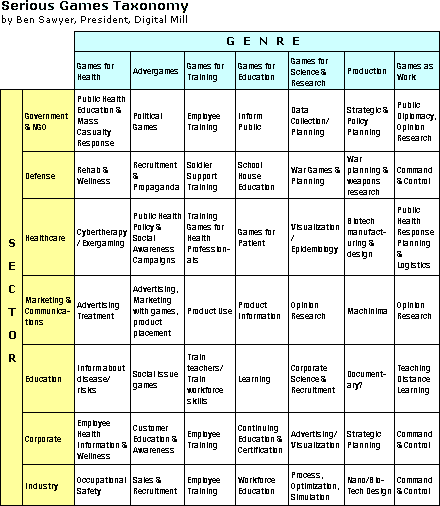Later in the day after seeing technology expert Robin Raskin speak as mentioned in my prior post, I received news that Ben Sawyer, pioneer in the Serious Games movement and founder of the company Digital Mill, would be speaking at MIT. Little did I know the presentation he was about to deliver was a preview of new material for the upcoming USC Annenberg Workshop on Games for Learning.
Ben began the presentation with a very fitting poem by John Godfrey Saxe about six blind men who went to see an elephant. Each blind man found a part of the elephant; it’s sturdy side by one, a tusk by another, an ear by yet another, and so on. Each blind man thought they had come to understand the true meaning of what an elephant is. Each person was partially right about what they thought was an elephant, yet all of them were wrong in their understanding.
I found this poem helpful in describing my early frustration with Serious Games. I consider myself part of the learning games community; Yet, as I read through the serious games online posts and meet other community members outside of my space, like in corporate training or the military, I’ve asked myself many times, are we really working towards the same common goal? Do we see the same elephant? After hearing this poem I’ve felt a sense of deja-vu, having been in the same place maybe fifteen years prior as multimedia and the interactive industry tried to define itself as a new business worth pursuing. Now that we can better classify different parts of that earlier beast, and see and understand the whole as well as its parts, we begin the process again, unfolding this new chapter in the digital domain.
Ben unveiled his taxonomy of Serious Games, a matrix that attempts to define the different parts of this industry (Click to download an Excel copy of the Serious Games Taxonomy). When speaking with Ben after his presentation, he mentioned how this taxonomy is indeed a work in progress, that this information not only had a height and width, but a depth that’s not reflected here. In discussing this early version with others, a few holes and additional serious games classifications appear to be missing. None the less, this effort is an excellent first mapping of the field.
After seeing this Serious Games Taxonomy, I can more easily see where communication breakdown occurs. I can also see the differences and similarities of my own company in context to others. I think we can now begin to see the whole elephant and are on our way to more meaningful dialog about the differences between a trunk and a tail.




